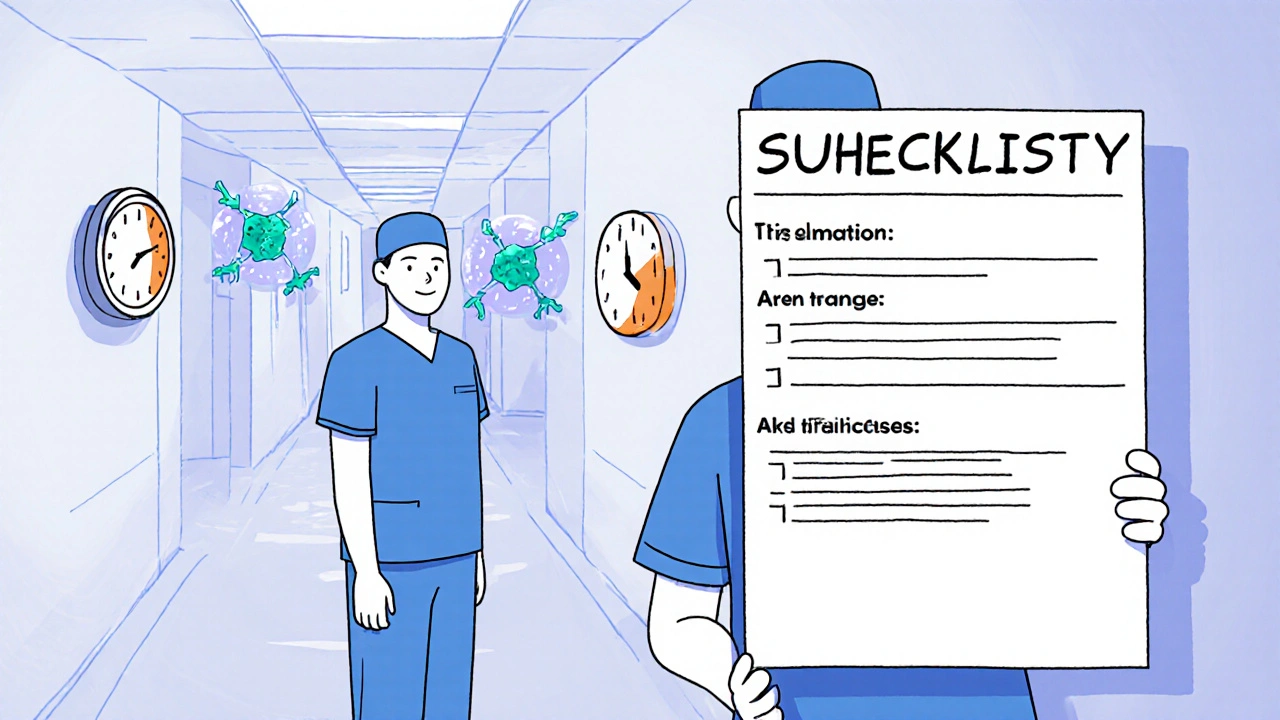Cephalexin Prophylaxis Dosage Calculator
Cephalexin Dosing Calculator
Calculate the appropriate cephalexin dose for surgical prophylaxis based on kidney function and body weight
Recommended dose:
No calculation yet
Timing: 30-60 minutes before incision
Duration: Up to 24 hours total
Key Takeaways
- Cephalexin is an oral, first‑generation cephalosporin that works well for clean‑contaminated surgeries when patients can’t receive IV drugs.
- Give the dose 30‑60 minutes before incision to hit peak tissue levels during the operation.
- Standard adult dose is 1 g every 6 hours for 24 hours; adjust for kidney function and body weight.
- Compare cephalexin with cefazolin (IV) and clindamycin (alternative for MRSA) to pick the right drug for each case.
- Watch for rash, diarrhea, and rare allergic reactions; document any allergy history before prescribing.
Why Surgical Antibiotic Prophylaxis Matters
In any operation, the biggest fear for patients and surgeons alike is a surgical site infection (SSI). Even a small infection can turn a routine procedure into a weeks‑long hospital stay, extra antibiotics, and costly readmissions. The World Health Organization estimates that SSIs account for about 20 % of all hospital‑acquired infections worldwide. That’s why pre‑operative antibiotics are a non‑negotiable part of modern surgical safety checklists.
Antibiotic prophylaxis isn’t about treating an infection that’s already there. It’s about flooding the surgical wound with enough drug to kill bacteria the moment they’re introduced. The timing, choice of drug, and dose all drive how well this strategy works.
Cephalexin Basics
Cephalexin is a first‑generation oral cephalosporin antibiotic that targets Gram‑positive bacteria and some Gram‑negative organisms. It blocks bacterial cell‑wall synthesis, making it bactericidal. Because it’s taken by mouth, it avoids the need for an IV line, which is handy for outpatient or short‑stay surgeries where patients can swallow a pill before heading to the OR.
Cephalexin covers common skin flora like Staphylococcus aureus (including methicillin‑susceptible strains) and streptococci, which are the usual culprits in clean‑contaminated procedures such as breast augmentations, hernia repairs, and certain orthopedic interventions.
When to Choose Cephalexin for Prophylaxis
Guidelines from the American Society of Health‑System Pharmacists (ASHP) and the Surgical Infection Society suggest cephalexin when:
- The surgery is classified as “clean” or “clean‑contaminated”.
- The patient can take oral medication without risk of aspiration.
- There’s no evidence of beta‑lactam allergy (or a documented non‑severe reaction).
- Local resistance patterns show Staphylococcus aureus remains sensitive to first‑generation cephalosporins.
If any of these conditions aren’t met-like a high‑risk MRSA prevalence or a severe penicillin‑allergic patient-alternatives such as cefazolin (IV) or clindamycin become more appropriate.

Dosage, Timing, and Duration
Getting the drug into the tissues at the right moment is the single most important factor. Studies show a 30‑ to 60‑minute window before incision yields the highest SSI reduction.
- Standard adult dose: 1 g of cephalexin taken orally.
- Timing: Administer 30 minutes before the surgical incision. If the patient can’t swallow that early, give it as close as possible to the 60‑minute mark.
- Redosing: For procedures lasting longer than 4 hours, give a repeat dose 6 hours after the first.
- Duration: Keep prophylaxis to 24 hours total (usually 2‑3 doses). Extending beyond that offers no extra SSI protection and increases resistance risk.
Kidney function matters because cephalexin is cleared renally. For a creatinine clearance < 30 mL/min, drop the dose to 500 mg every 12 hours.
How Cephalexin Stacks Up Against Other Prophylactic Options
Most surgeons think of IV cefazolin first, but oral cephalexin can be a practical alternative. Below is a quick side‑by‑side look at the three most common agents.
| Attribute | Cephalexin (oral) | Cefazolin (IV) | Clindamycin (IV/PO) |
|---|---|---|---|
| Route | Oral | Intravenous | IV or oral |
| Primary coverage | MSSA, streptococci | MSSA, streptococci, some gram‑negatives | Anaerobes, MRSA (partial) |
| Typical dose | 1 g PO | 2 g IV | 600 mg IV/PO |
| Timing window | 30‑60 min pre‑incision | 15‑45 min pre‑incision | 60‑120 min pre‑incision |
| Allergy concerns | Beta‑lactam (cephalosporin) - cross‑reactivity < 10 % | Beta‑lactam - same as above | Clostridioides difficile risk, GI upset |
| Cost (US, 2025) | ~$0.50 per 500 mg tablet | ~$5 per gram | ~$12 per 600 mg dose |
When cost, ease of administration, and patient comfort matter, cephalexin often wins. However, if the surgery involves significant exposure to anaerobes (e.g., colorectal work) or the patient has a known severe beta‑lactam allergy, clindamycin becomes the go‑to choice.
Risks, Side Effects, and Monitoring
All antibiotics carry a risk of adverse events. With cephalexin, the most common issues are:
- Gastro‑intestinal upset (nausea, mild diarrhea).
- Transient rash, especially in patients with a prior mild penicillin reaction.
- Rare but serious allergic reactions (anaphylaxis); always have emergency meds nearby.
Because cephalexin is excreted unchanged in urine, watch for accumulation in patients with chronic kidney disease. A simple creatinine check the day before surgery helps you decide whether to adjust the dose.
Document any allergy or side‑effect history in the electronic health record. The WHO Surgical Safety Checklist now includes a specific item for “antibiotic prophylaxis given and timing confirmed,” which reminds the whole team to double‑check these details.

Practical Checklist for the OR Team
- Verify patient’s allergy status and renal function during pre‑op assessment.
- Confirm the surgery falls under clean or clean‑contaminated category.
- Order 1 g cephalexin PO to be administered 30‑60 minutes before incision.
- If surgery exceeds 4 hours, schedule a repeat dose at the 6‑hour mark.
- Document time of administration on the surgical “time‑out” sheet.
- Monitor for immediate reactions; have epinephrine ready.
- Stop prophylaxis after 24 hours unless a post‑operative infection is diagnosed.
Following this list reduces missed doses and keeps the focus on patient safety rather than paperwork.
Frequently Asked Questions
Can I take cephalexin if I’m allergic to penicillin?
Most people with a mild penicillin allergy tolerate cephalexin because cross‑reactivity is less than 10 %. However, if you’ve had an anaphylactic reaction to penicillin, avoid cephalexin and choose a non‑beta‑lactam option like clindamycin.
Why not just use IV cefazolin for every case?
IV cefazolin is excellent, but it requires an IV line, extra nursing time, and higher drug cost. For short, low‑risk procedures where oral intake is safe, cephalexin gives similar SSI protection with fewer logistical hurdles.
What if my surgery lasts longer than 6 hours?
Give a repeat 1 g dose of cephalexin 6 hours after the initial dose. Some surgeons prefer a single IV dose of cefazolin for very long cases, but redosing oral cephalexin works well if IV access isn’t practical.
Is a single dose enough for orthopedic implants?
For most clean orthopedic implants, a single pre‑op dose plus a 24‑hour repeat (if the patient is high‑risk) meets guideline recommendations. Prolonged prophylaxis beyond 24 hours has not shown additional benefit and may raise resistance concerns.
How does kidney disease affect cephalexin dosing?
Reduce the dose to 500 mg every 12 hours for patients with creatinine clearance under 30 mL/min. In end‑stage renal disease on dialysis, give 250 mg after each dialysis session if a dose is needed.
Bottom Line
When used correctly, cephalexin preoperative prophylaxis is a safe, cost‑effective way to keep surgical wounds clean, especially for outpatient or short‑stay procedures where an IV line would be overkill. The key is timing the dose right, checking allergies, and adjusting for kidney function. Pair the drug with the WHO Surgical Safety Checklist, and you’ve got a solid defense against post‑operative infections.

All Comments
Harry Bhullar October 20, 2025
Cephalexin as a pre‑op prophylactic is a solid option when you want to avoid an IV line. The drug hits peak tissue concentrations about 30‑60 minutes after ingestion, which matches the ideal surgical window. Because it's oral, the logistics are simpler for ambulatory procedures and you save on nursing time. The standard adult dose of 1 g every six hours for 24 hours gives reliable coverage against MSSA and streptococci. If the patient has reduced renal clearance, dropping to 500 mg every 12 hours prevents drug accumulation. Timing is everything; giving the pill too early or too late can blunt its protective effect. Studies show that a well‑timed dose can cut surgical site infection rates by roughly 20 % in clean‑contaminated cases. Cost is another advantage: at about fifty cents per tablet, it’s far cheaper than the IV alternatives. Compared with cefazolin, cephalexin avoids the need for an IV push and the associated line‑related complications. For patients with a mild penicillin allergy, cross‑reactivity is below ten percent, making it a reasonable choice. However, anyone with a history of anaphylaxis to beta‑lactams should be steered toward clindamycin or another class. The WHO surgical safety checklist now explicitly calls out confirming antibiotic timing, which helps the whole team stay coordinated. In practice, adding the dose to the pre‑operative medication list and documenting the exact minute on the time‑out sheet eliminates missed doses. Redosing after four hours for longer cases maintains therapeutic levels without over‑exposing the patient. Remember to re‑evaluate renal function each day if the surgery extends beyond the first 24 hours. All in all, when you line up the right patient, the right timing, and the right dose, cephalexin is a cost‑effective and safe way to keep surgical wounds clean.
Dana Yonce October 31, 2025
Nice rundown, really helpful! 😊
Xavier Lusky November 10, 2025
Sure, but have you considered that the pharma lobby pushes cheap oral meds like cephalexin to keep hospitals buying more expensive IV drugs later on?
Ashok Kumar November 20, 2025
Oh, brilliant, because we all love another pill to swallow right before we’re knocked out on the table – what a thrill.
Jasmina Redzepovic November 30, 2025
From a pharmacoeconomic standpoint, cephalexin's bioavailability and cost-per-dose ratio significantly undercuts the marginal utility of cefazolin in outpatient settings.
The CDC's SSI reduction algorithms explicitly factor in antimicrobial stewardship metrics, thereby incentivizing agents with lower collateral damage.
Moreover, the drug's pharmacokinetic profile aligns with the AUC/MIC targets recommended for Gram‑positive prophylaxis.
In institutions where the antibiogram reveals >90 % susceptibility of Staphylococcus aureus to first‑generation cephalosporins, the decision matrix tilts decisively toward oral cephalexin.
Conversely, in high MRSA prevalence zones, the algorithmic substitution of clindamycin or vancomycin becomes statistically justified.
Operationally, the avoidance of peripheral IV cannulation reduces nursing workload by an estimated 15 % per case.
The statutory compliance checklist now mandates documentation of renal function stratification prior to dose adjustment, which dovetails neatly with EMR decision support.
In sum, integrating cephalexin into the prophylactic armamentarium is both a fiscally responsible and clinically sound maneuver for the modern OR.
Esther Olabisi December 10, 2025
Sounds like a perfect plan, especially if we love spreadsheets more than patients 🙃💊.
Sakib Shaikh December 20, 2025
Yo, i cant beleve how u r all talkin bout cost n' stuff while we sit here waitin for the cut! It's like drama in a med school movie!!!